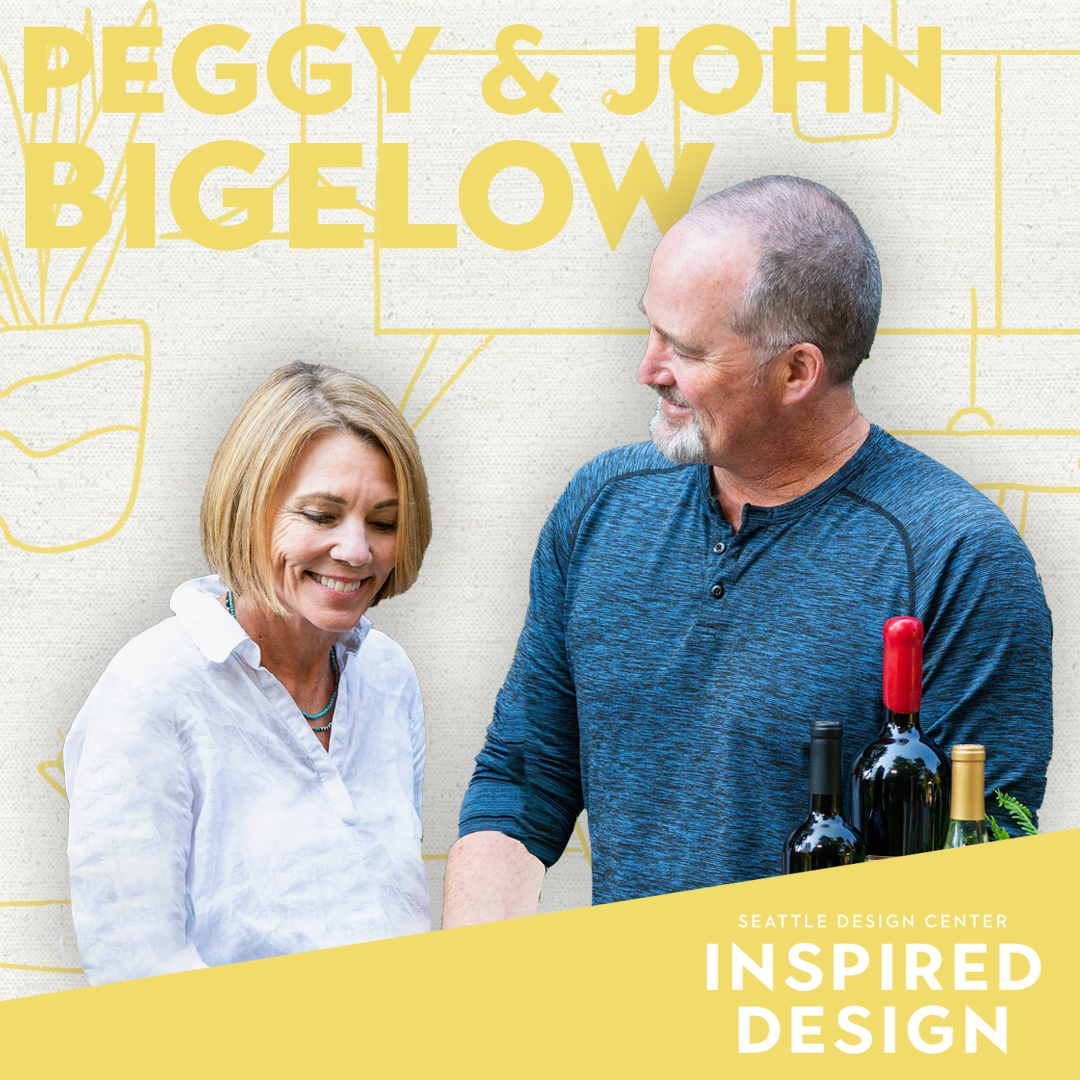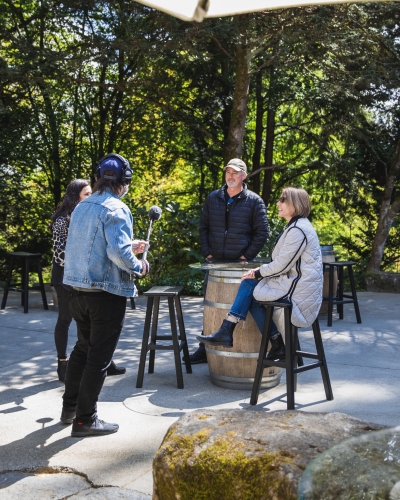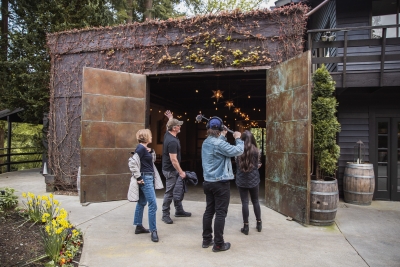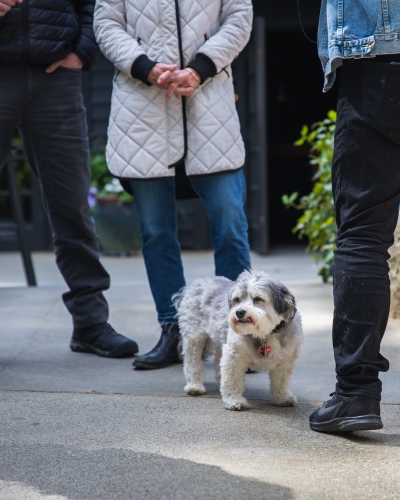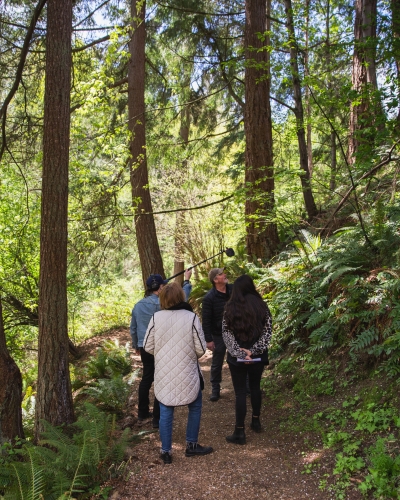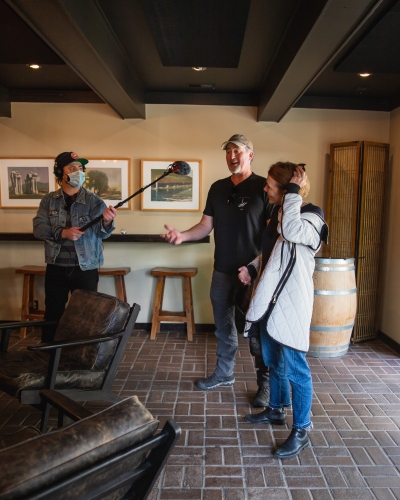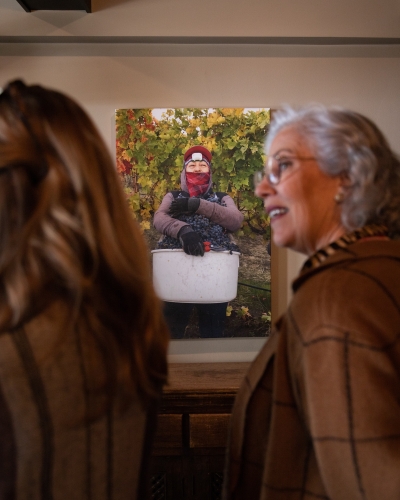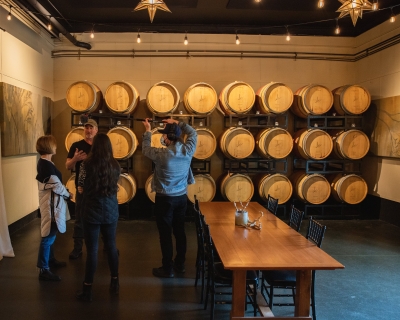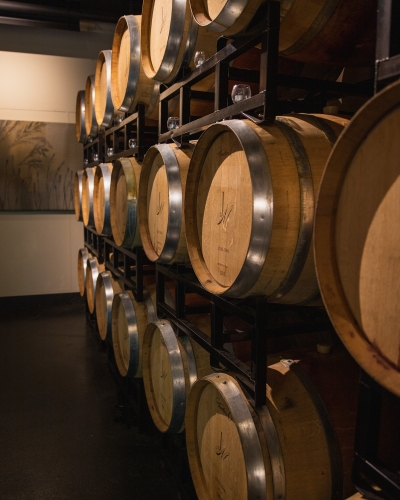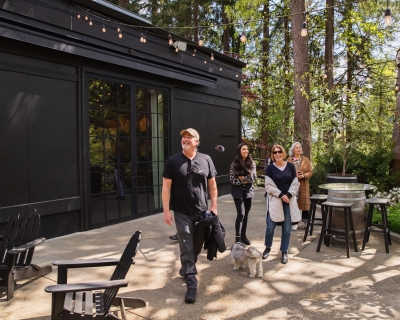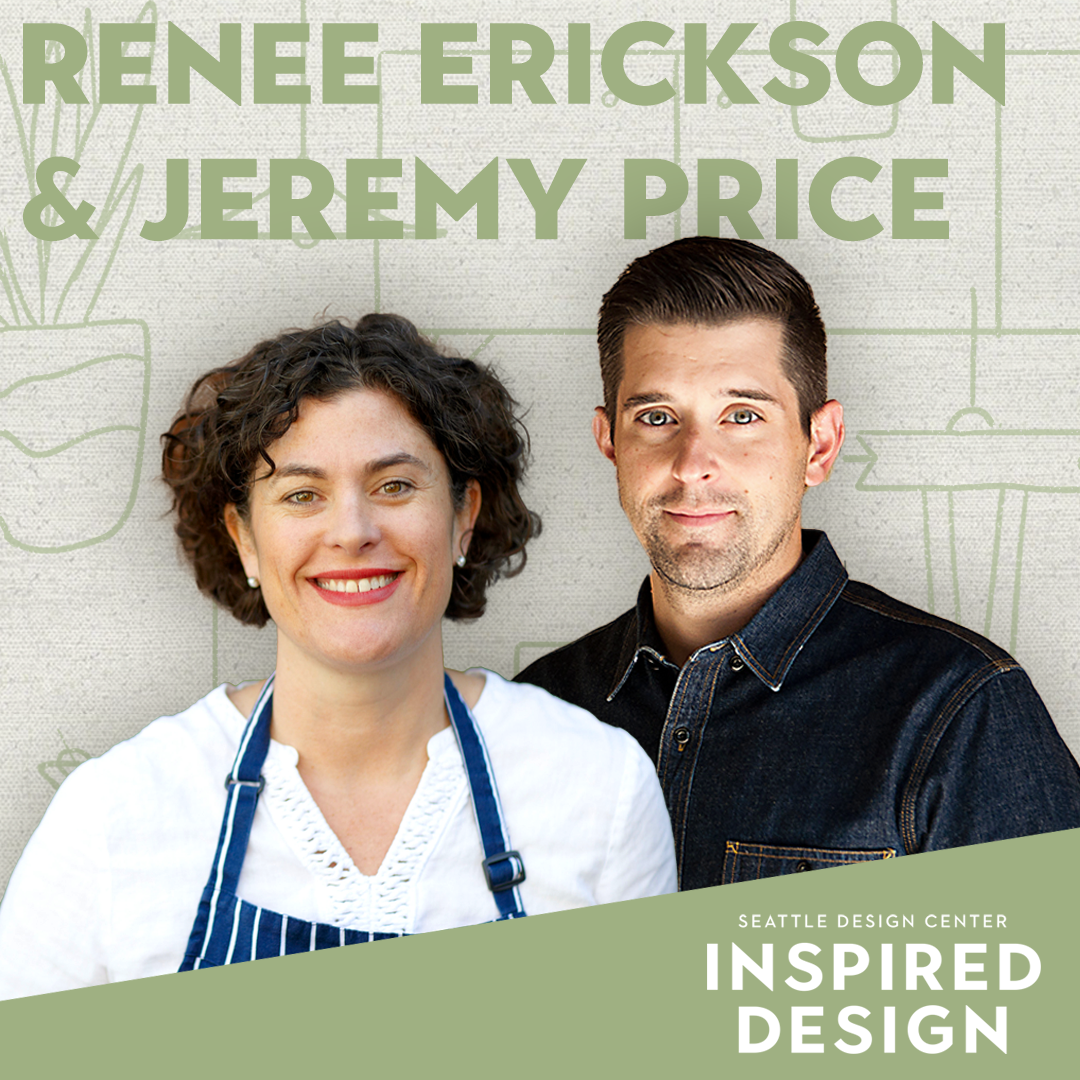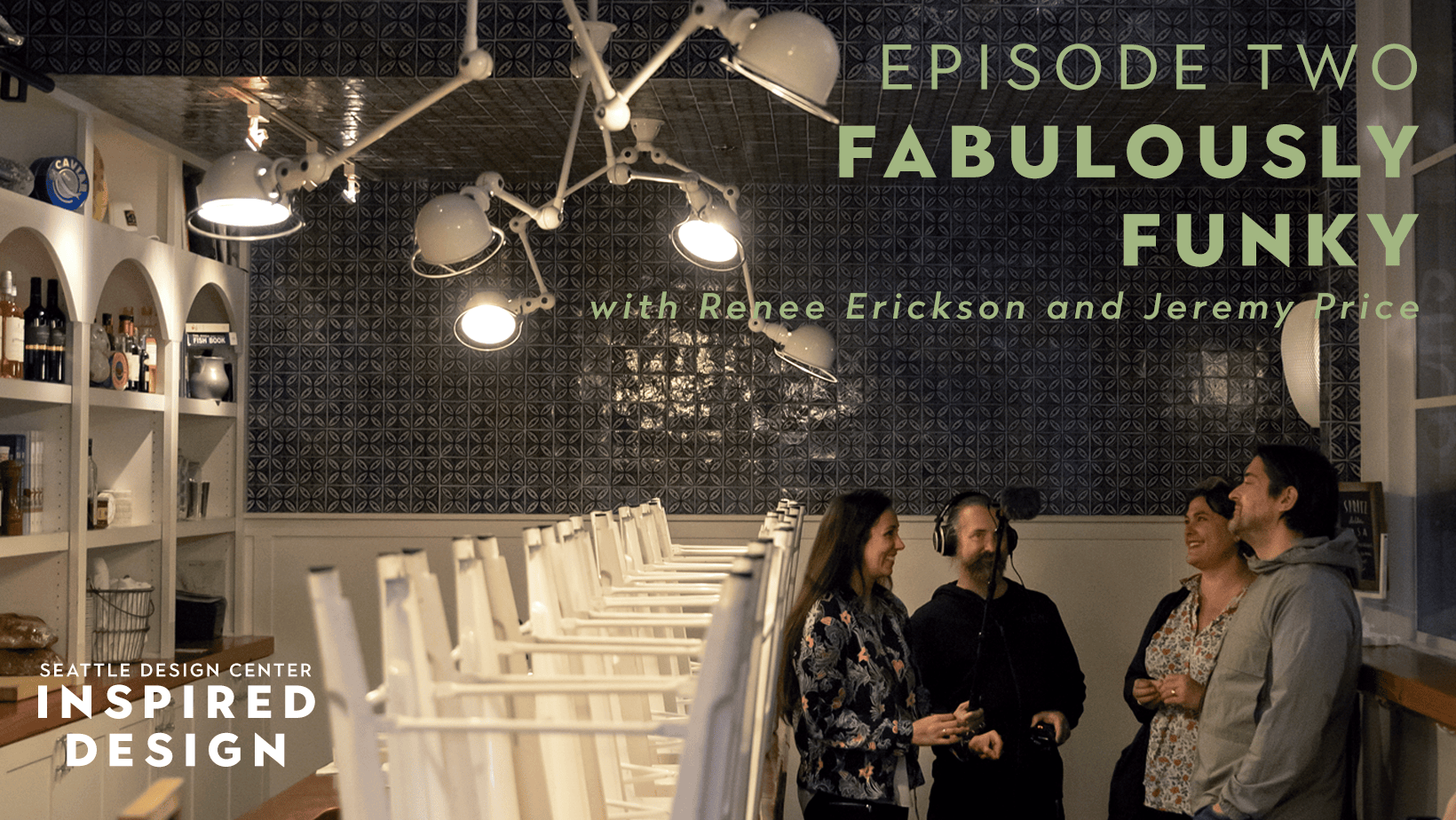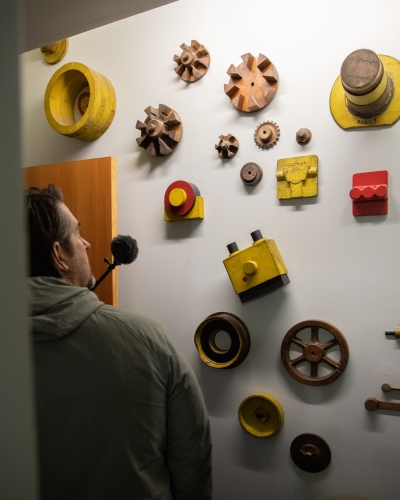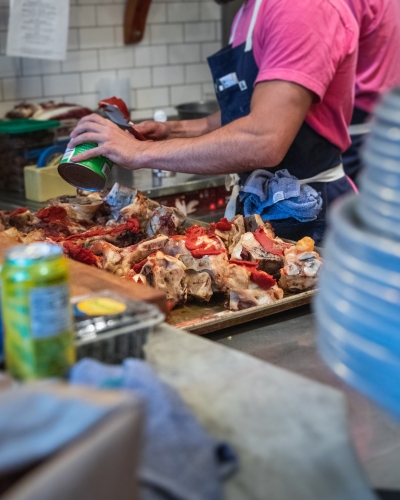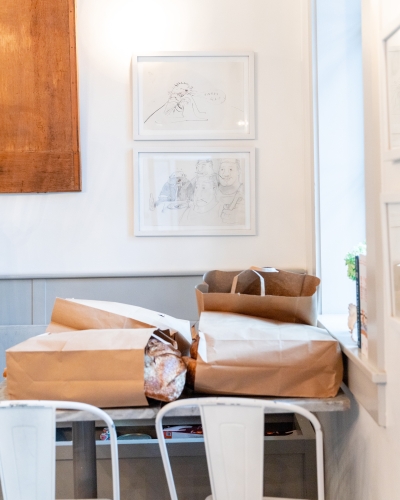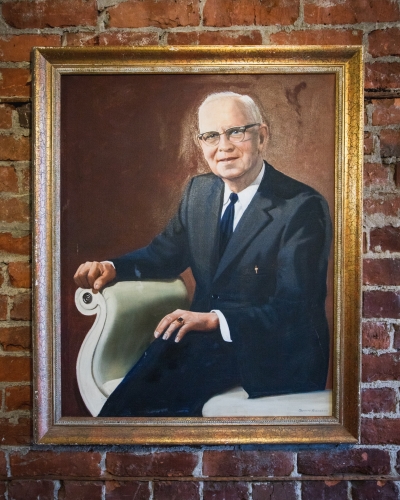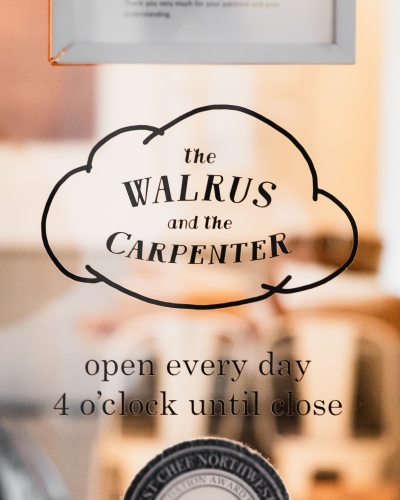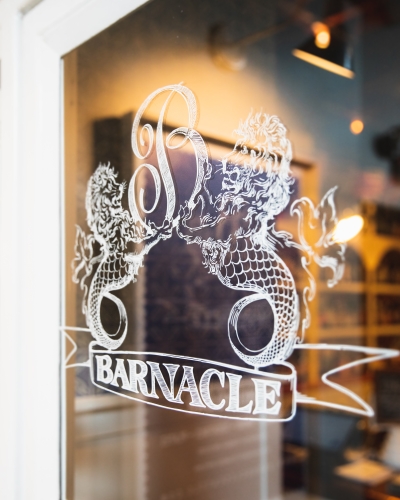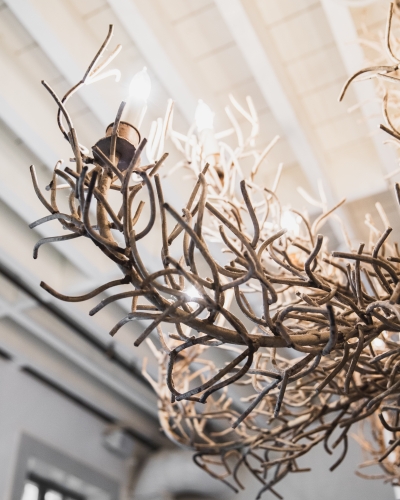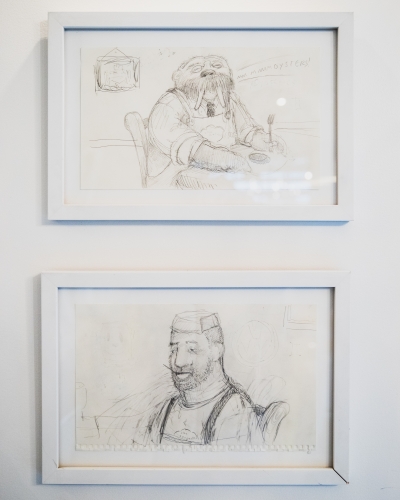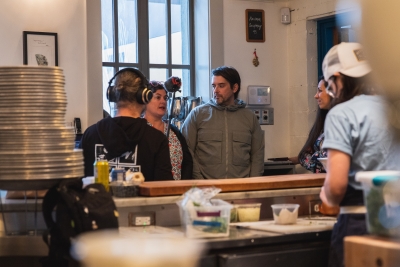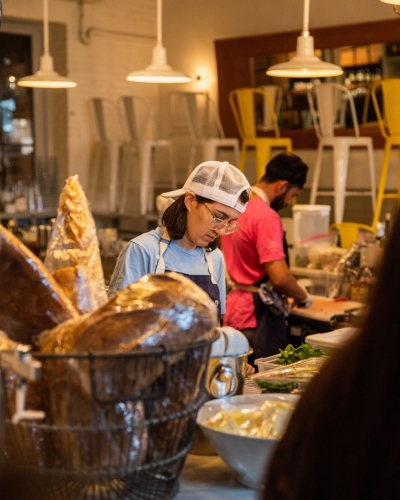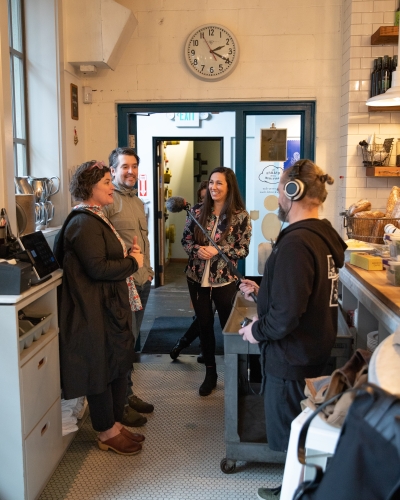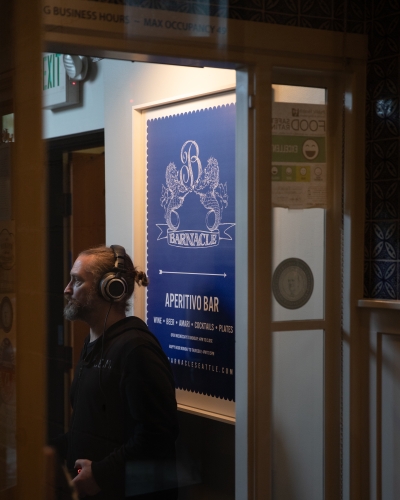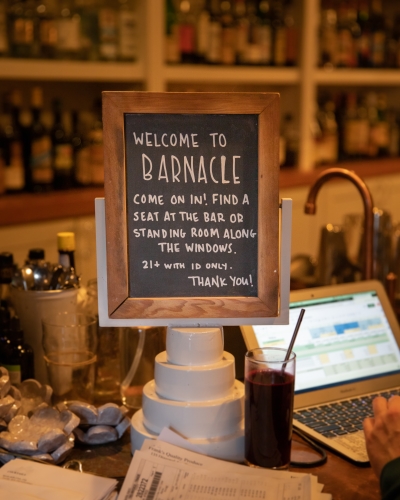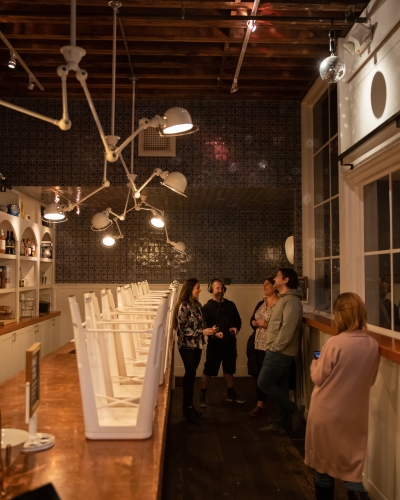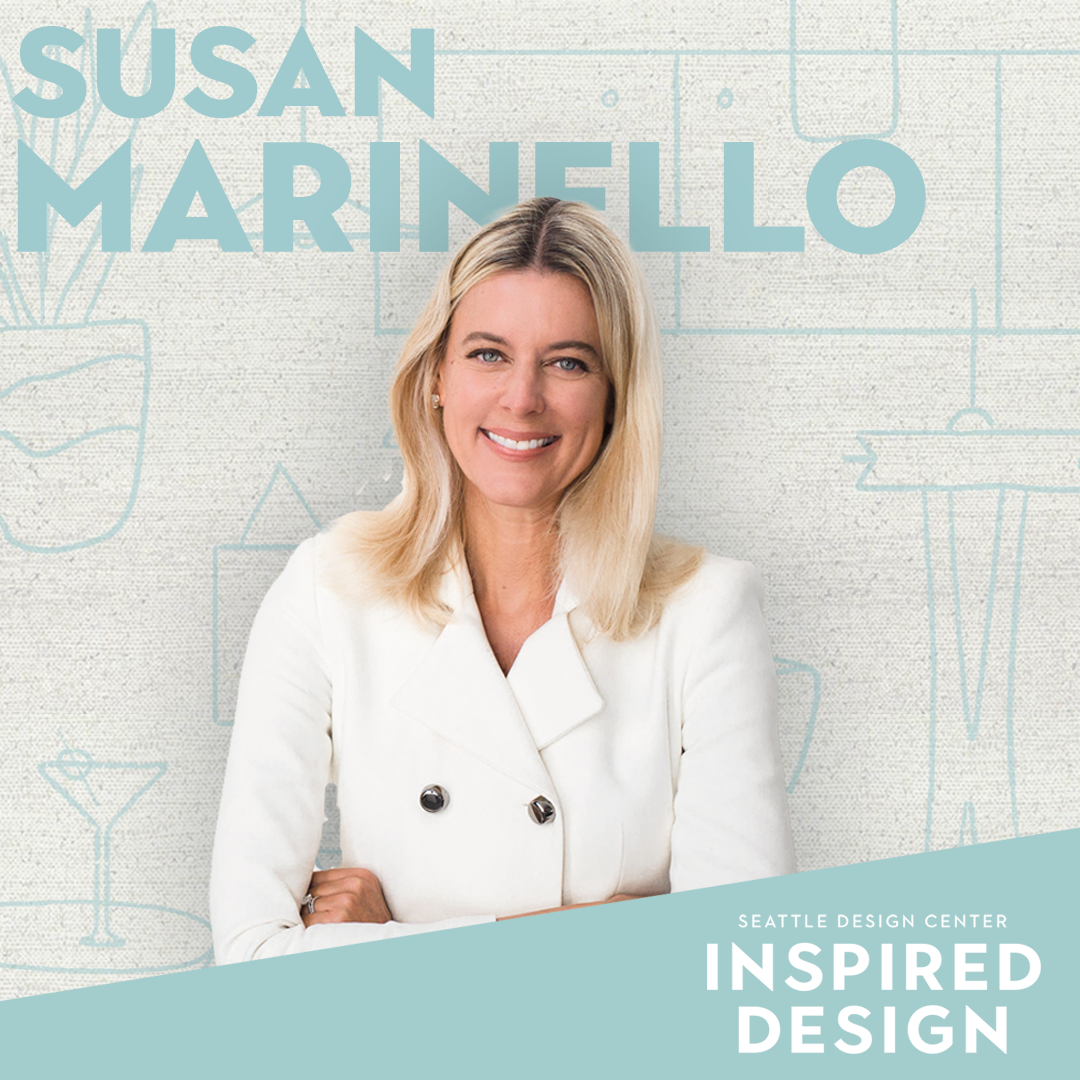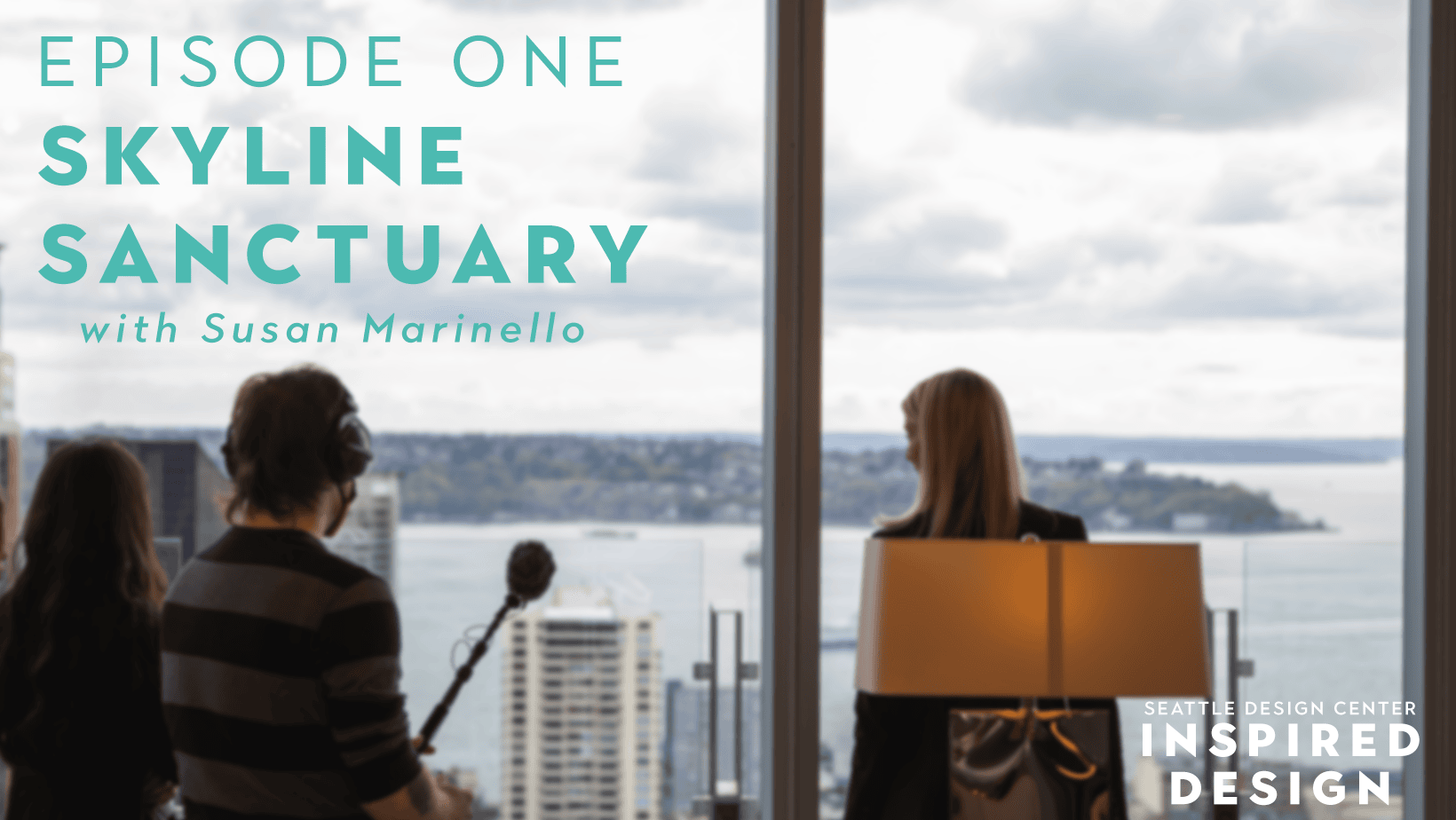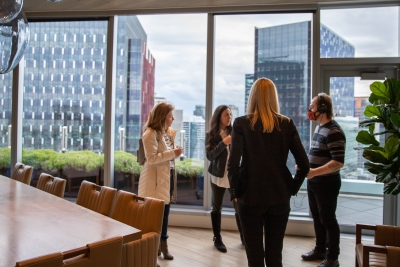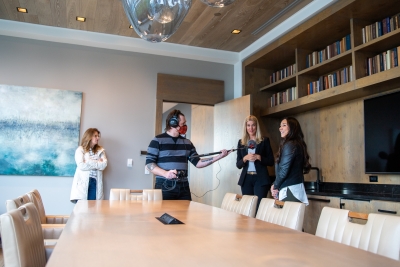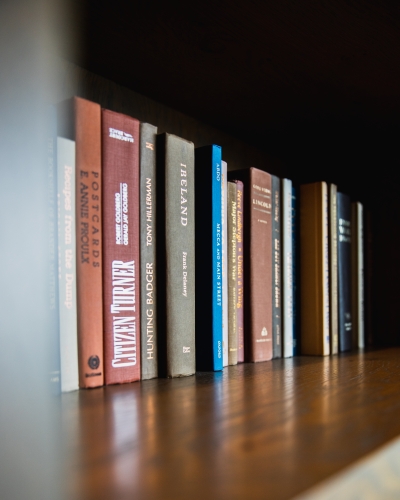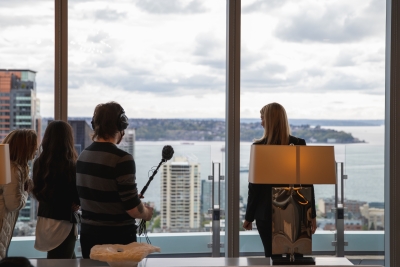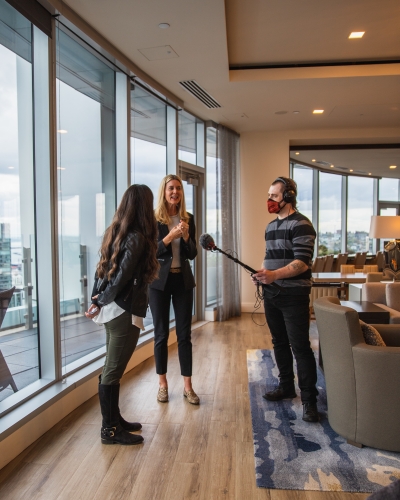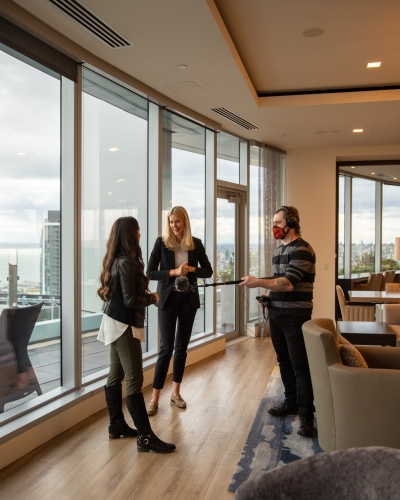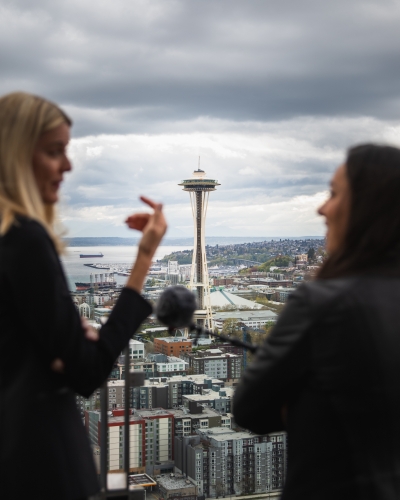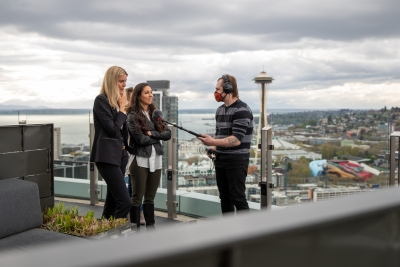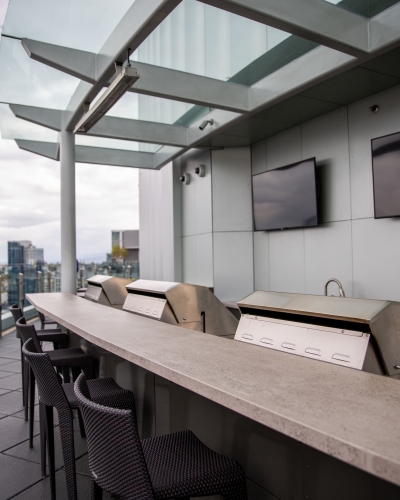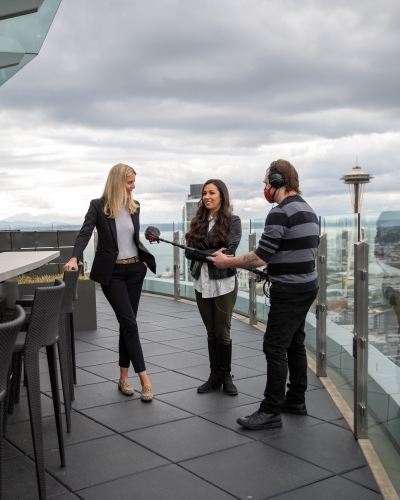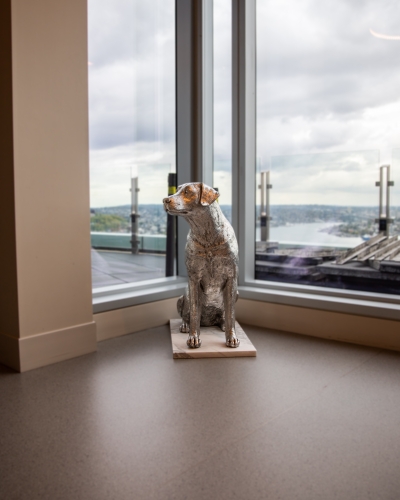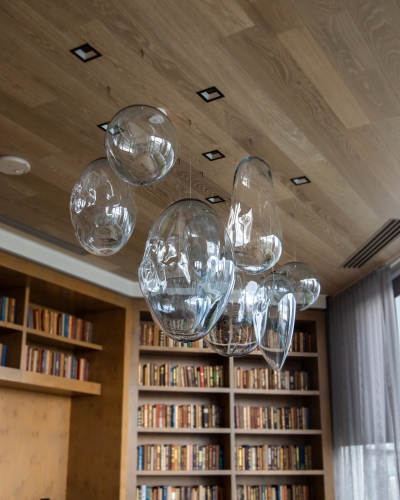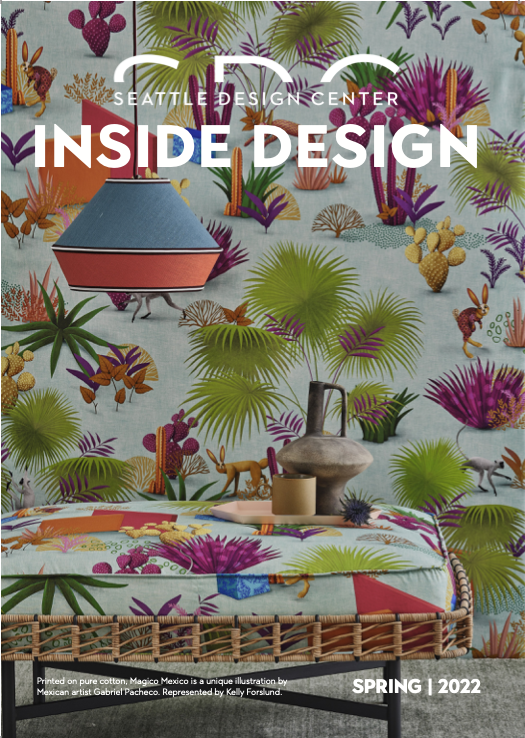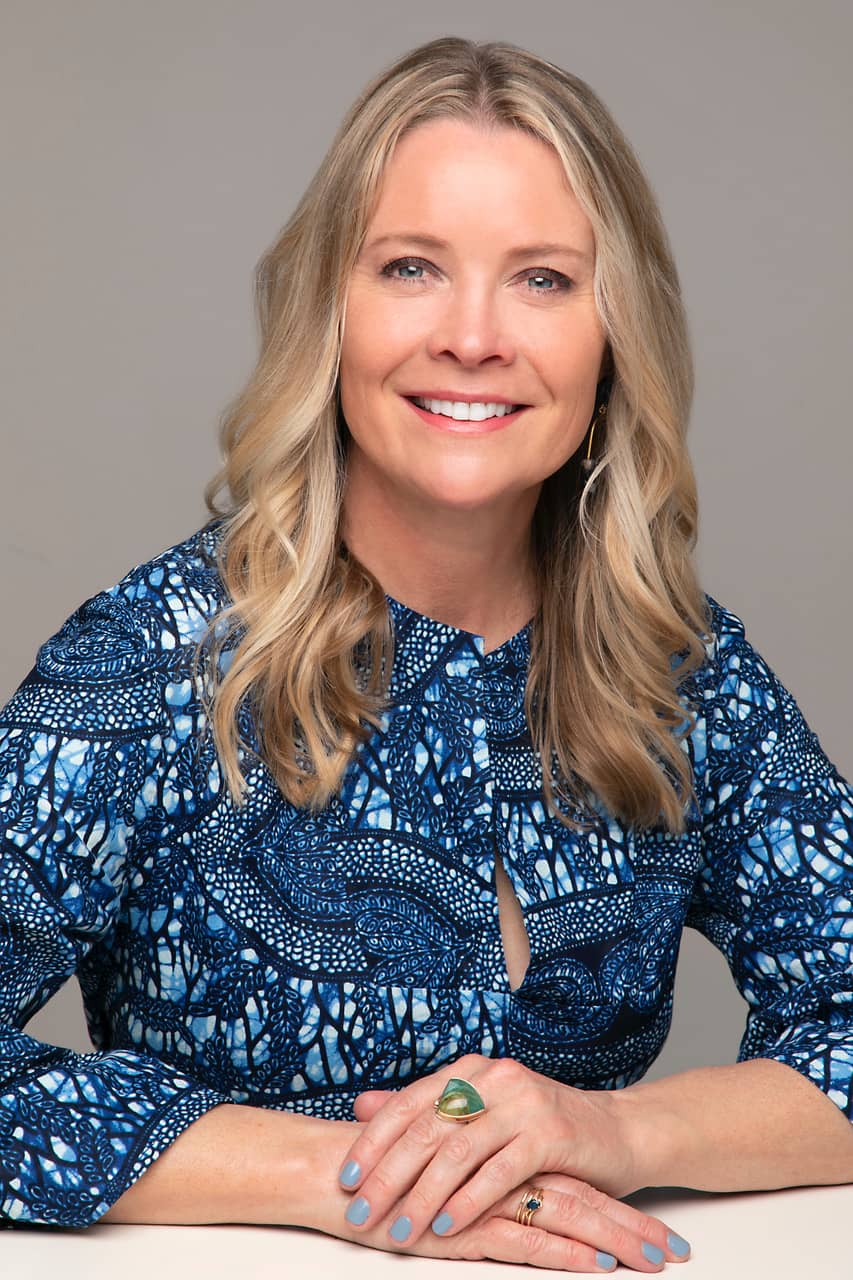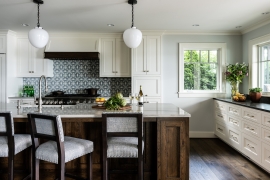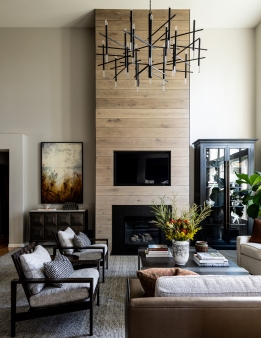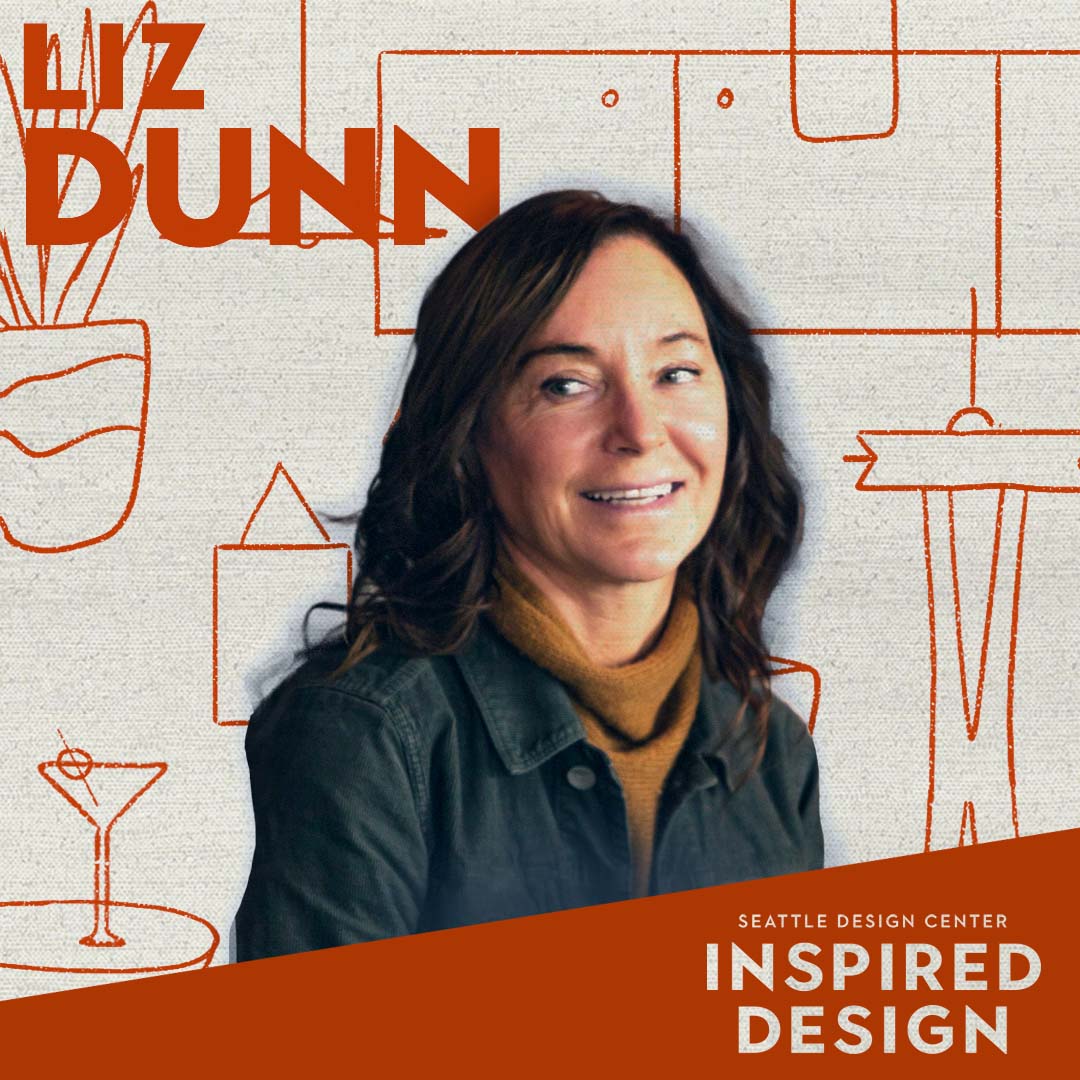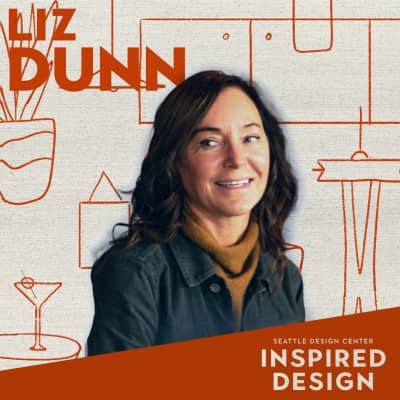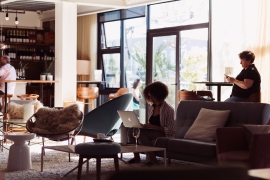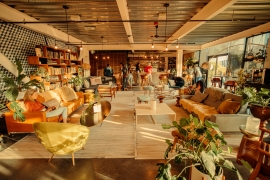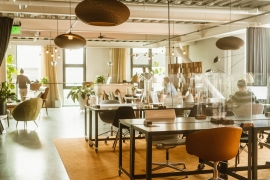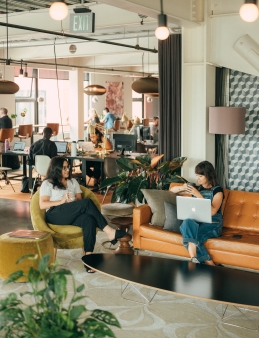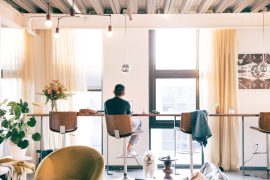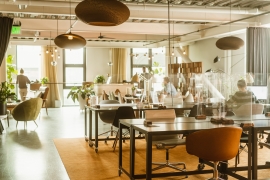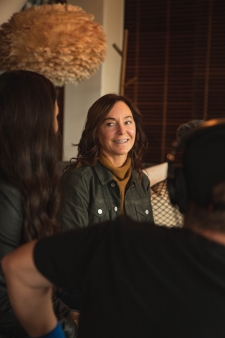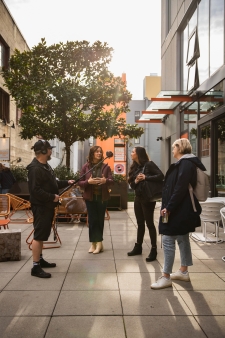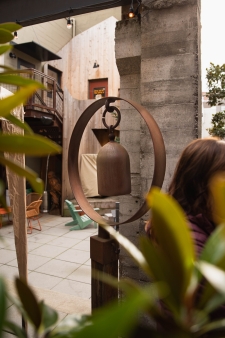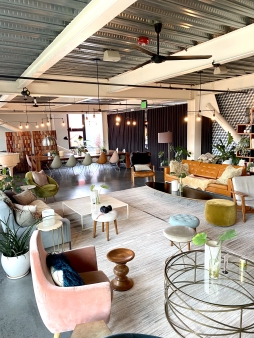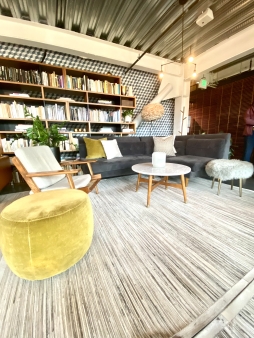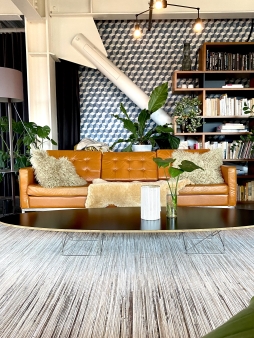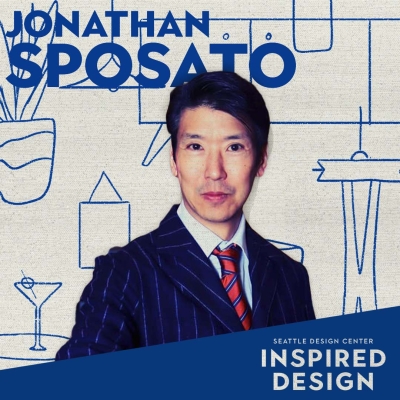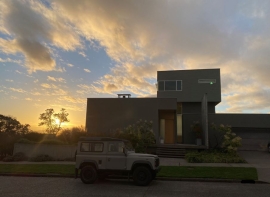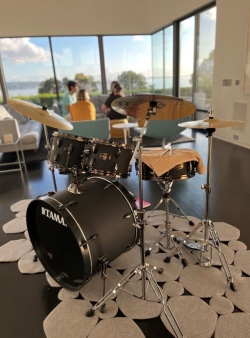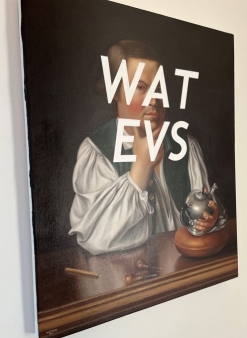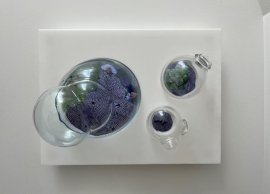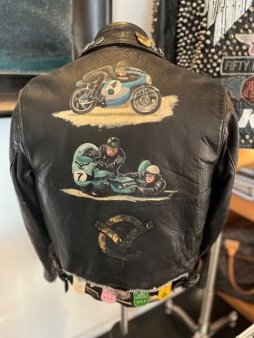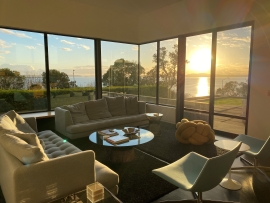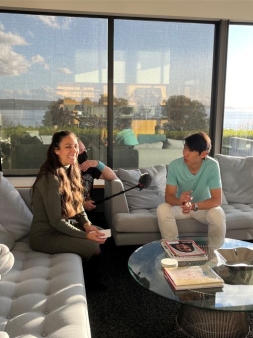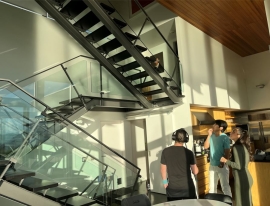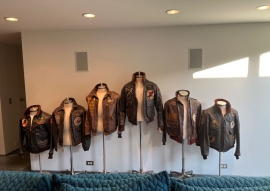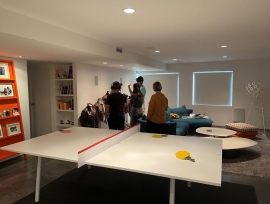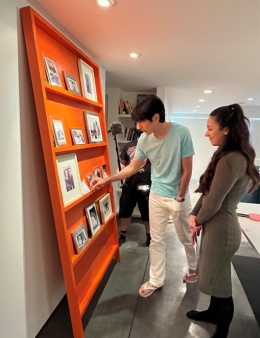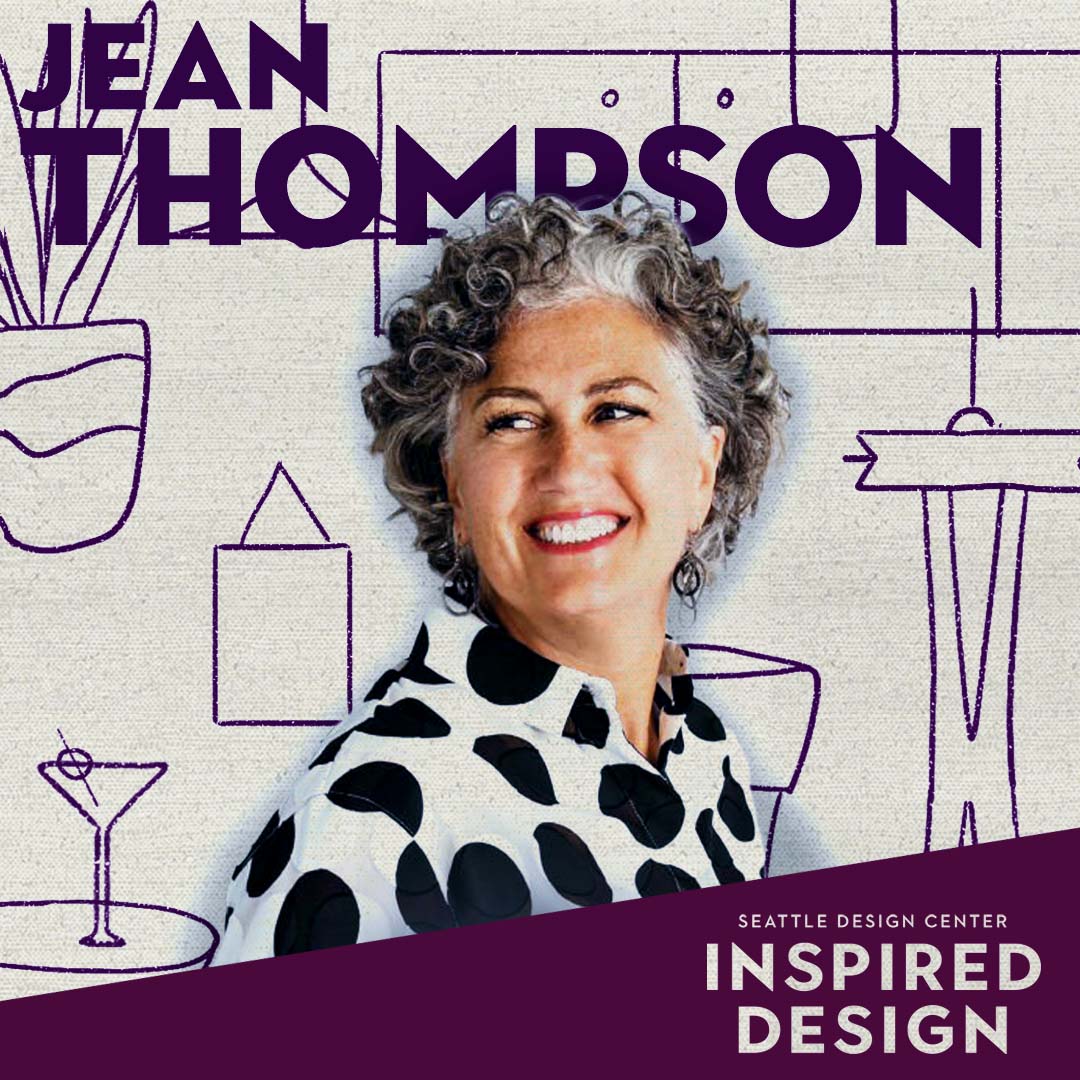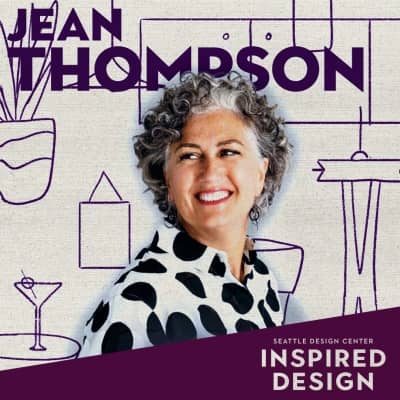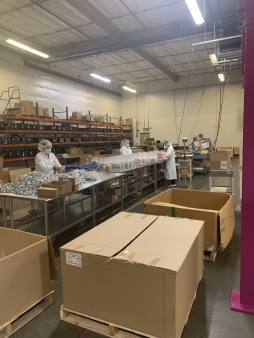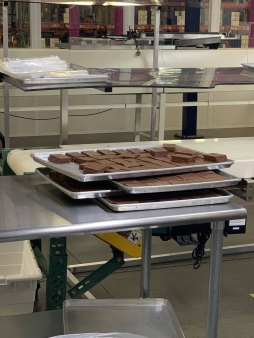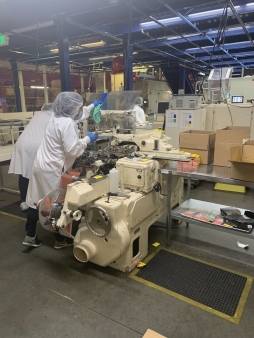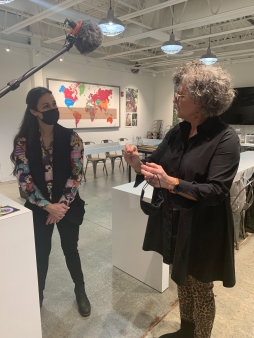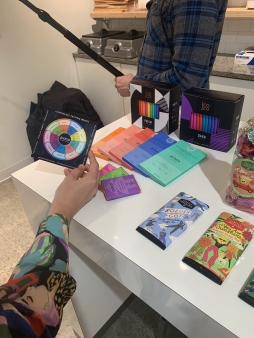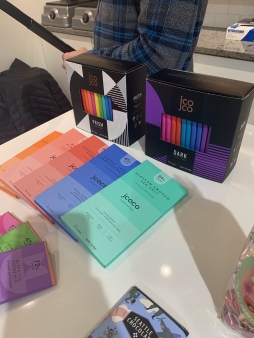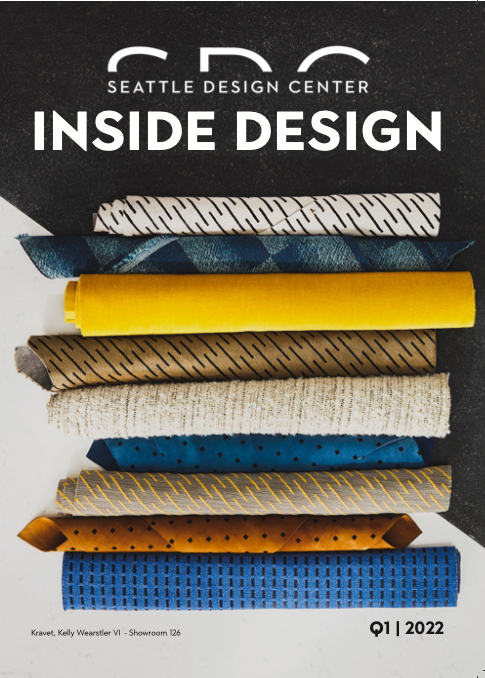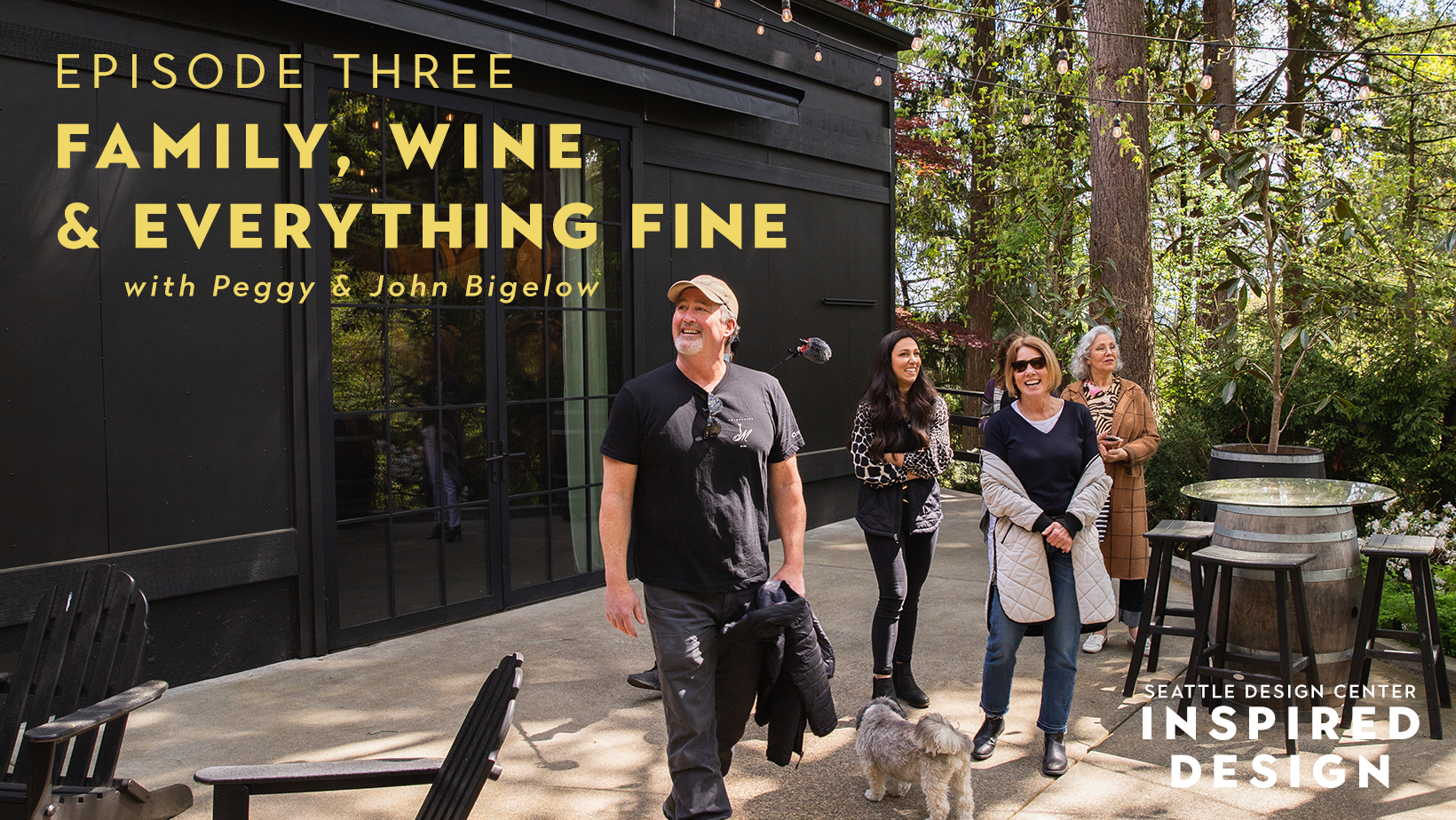
Peggy & John Bigelow | Family, Wine & Everything Fine
In this episode of Inspired Design, we follow the aroma of wine to JM Cellars where we meet founders, Peggy & John Bigelow. This Woodinville winery is more than just fine wine. It’s a haven for new ideas, passion projects, and community. Learn how the Bigelow’s transformed old dairy farmland into the ultimate Pacific Northwest gathering place.
Listen on your platform of choice
[abcf-grid-gallery-custom-links id=”5750″]
Explore this Episode
Behind the scenes
EPISODE’S LOCATION
VALUES
With community, family and friendship in mind, John & Peggy Bigelow’s vision for their boutique winery was to create a space that embodied these values while upholding the wishes of the land’s previous owners and preserving historic Woodinville farmland. The result was Bramble Bump, a 7-acre, organically gardened, intimate, warm and quintessentially northwest treasure.
THE WINES
Originally produced onsite at Bramble Bump, JM Cellars’ winemaking program remains focused on creating handcrafted, limited release wines. With fruit sourced from premier vineyards throughout the state, JM’s portfolio of new world wines draws inspiration from various wine regions around the world and utilizes old world winemaking techniques.
THE VENUE
From wine-inspired events like blendings and tastings, corporate retreats including off-site meetings and team building events or the dreamiest, northwest wedding, Bramble Bump is the perfect canvas for all occasions.
THE CLUB
Wine tasting benefits, exclusive club discounts, private social club-only events & limited release wines are just a few of the perks of JM Cellars’ Wine Club. Celebrating community and wine exploration, we welcome you to join the JM Family!
Speaker 1 (00:00):
When we were building this Peggy and I had gone to Europe and, and had a chance to go through France and Italy and see some incredible wineries and the common denominator of all these great wineries was really cool doors. So we had this guy called the tin man. Yep. What’s his
Speaker 2 (00:18):
Name? Doug. Doug French,
Speaker 1 (00:19):
Doug French.
Speaker 2 (00:20):
And I think he’s retired now. These
Speaker 3 (00:22):
Are giant doors.
Speaker 2 (00:23):
Yeah.
Speaker 1 (00:24):
Yeah. Very large copper doors. Um, when he made them, you know, it’s, it’s a 10 foot high, 10 foot wide space. So it was, uh, two 10 by five, uh, doors that he created. They weigh 600 pounds each. He, they were so big. He wasn’t even sure they’d stay up. So we had to hang him first to make sure that they stayed up and they were shiny, bright copper. Um, he took ’em back down, put ’em on, saw horses. He had acid spray and sprayed on the doors and then had blow torches and was blow torching it for two days. And he pulled out all this turquoise patina in the door, which is really cool. But what he didn’t realize was that I was gonna be fermenting grapes in this front room. And when you ferment, you actually blow off CO2 and the CO2 is full of acid. And so all of this purple patina that kind of weaves into the door, uh, came from our fermentations. And so when he came out to visit, he was like, how did you do that? I really want to, eh, you just gotta start a winery, Doug. That’s all they have become a moniker for us, for sure. But enough on the doors. Right? <laugh> that’s cool. Head
Speaker 4 (01:37):
On in
Speaker 3 (01:41):
I’m Gina Colucci with the Seattle design center every week on inspired design, we sit down with an iconic creator in a space that inspires them this week on inspired design, Peggy and John Bigelow of JM sellers, along with their dog, Billy take us through their beautiful winery and estate in Woodenville.
Speaker 2 (02:00):
Hi, I’m Peggy Bigelow and I am owner and president of JM sellers. We have two retail outlets and a production facility, one in Woodenville and one in Malley,
Speaker 1 (02:12):
Washington, I’m John Bigelow and I’m the, uh, winemaker and owner. And I report to Peggy and have for 32 years. <laugh>
Speaker 3 (02:20):
Peggy and John have owned and operated JM sellers together for 19 years. Ever since John a former software executive decided to take the leap and pursue his passion for wine making together. John and Peggy grew JM sellers into one of the most respected wineries in Washington. The quality of their wine and the beauty of their property can most certainly be attributed to the loving and intentional way. They run their business, their 10 air business. They’re attentive to every detail on their property, which host weddings, wine club events, and weekend tastings. You pull up these beautiful iron gates and you come up the, the skinny driveway and you park, and you’re kind of in this like Pacific Northwest Oasis.
Speaker 1 (03:08):
Well, there’s a, a really incredible history actually to this whole Woodenville valley. And, uh, it goes back to the early 19 hundreds when this was all one big dairy farm. It was 550 acres of dairy farm out here and where we’re standing right now, we have, um, all these incredible trees. These days, we’ve got 120 Japanese Maples. We’ve got over 400 rare conifers on the, the property. But back in the early 19 hundreds, this was all grassland. This was, uh, where the cows would come to graze. There was a big dairy farm down in the right where St. Michelle is below us, uh, was a dairy farm. And it was actually a compound that was built by the Stimson family and the Stimsons were a timber barren family. So they had harvested almost all of the Douglas fur that was in this valley. Um, and they built, uh, houses down there. And some of those homes still stand over at St. Michelle. This area was just for cows to grace. So for close to 70 years, cows were up here, composting this soil in, uh, getting ready for all these trees to be planted.
Speaker 2 (04:16):
And the people who owned this before we did, they were in their eighties when they needed to move to more assist, you know, assisted living. And it was the daughter of one of the owners of the dairy farm after the Stimsons no longer owned it. And so this was her seven acre piece of land that she, it was will to her. She and her husband built the home here.
Speaker 1 (04:40):
You gotta tell the name. So her name was Jan McBride, but she was married to MTY Smith. And I love name MTY Smith, MTY
Speaker 2 (04:48):
Smith. And they were great horticulturalists. The, his family had a, uh, a nursery in the Northeast. So they brought back seedlings from the Northeast and planted here. And what was originally supposed to be a dwarf garden when you bring it into the Northwest and it rains a lot, and you have fertile soil from cow manure, it became this massive garden, and it is, uh, it’s a private Arboretum it’s been registered. Um, we’re bring it. It is, we’re bringing it back to registry. So it’s a, uh, truly registered private arboreum,
Speaker 1 (05:26):
It’s been amazing. So when we first saw this, uh, it didn’t look like it does today with, um, you know, all of our Japanese Maples and conifers right now are, are well taken care of. And, uh, when we first walked up here, it was very overgrown. Um, but you could tell that there was something special here.
Speaker 2 (05:46):
Oh, diamond in the
Speaker 1 (05:47):
Rock and then the house. Yeah, it was built in 1972. And if you imagine the Brady bunch running out onto the deck, that’s about the way the house looks, but it’s really beautiful and it fits the setting. And when we bought it, Peggy decided that we would not tear it down and build some strange Chateau, which we couldn’t have afforded to do anyway. But,
Speaker 2 (06:10):
Uh, thank God we had no
Speaker 1 (06:11):
Money. Yeah. But you know, we’re in Washington state with all these trees. And so she, she painted it very dark, um, gray. Do you call that dark gray?
Speaker 2 (06:20):
We call it dark black coffee
Speaker 1 (06:22):
Actually. Yeah. Okay. Dark black coffee. And, and it’s really, I think it just fits right in with the coffee
Speaker 2 (06:27):
Looks good with green. There’s a lot of green around,
Speaker 3 (06:29):
There’s so much lush greenery at jam sellers that I wondered how the property got its name. The Bramble bump.
Speaker 2 (06:37):
When we first arrived, there truly were Blackberry brambles covering so many Japanese Maples. They were just coming up this, this hill, this bump, and we had three little children. There was a watering system that wasn’t automated. So dragging hoses around to keep things alive was frightening for me. I was like, I don’t think I can. Thank God. Things were very mature.
Speaker 1 (07:05):
You don’t want to get into any more of the infrastructure here
Speaker 2 (07:08):
That we had
Speaker 3 (07:10):
That talk about a workout. Exactly.
Speaker 2 (07:11):
We figured out it was survival of the fittest. Yeah. We would do what we could and just let mother nature take its course. And so far, it’s, it’s worked out beautifully.
Speaker 1 (07:21):
Why don’t we do the outside first? Okay. And then we’ll go into the winery and the house and I’ll show you, but, uh, let’s go on down the walking path here. So, uh, this is a seven acre piece of property and, uh, uh, the top three acres are planted as the arboreum. Let me see
Speaker 3 (07:37):
A cute little walking path
Speaker 1 (07:39):
Side. Yeah. We’re going down the walking path. Now imagine a bride coming down here in her, uh, bridal gown. And that’s a good idea. This is where most of the brides get married in the summers outside, down here. Uh, when we started the winery, we had no idea that weddings were gonna be a part of our business plan. And about, uh, 10 years ago, we had a nice couple Janine and Brian ask us, could they get married here? And they really liked the way it looked. And, and we said, well, yeah, okay. And they said, well, you know, how much is that gonna be? And we said, we have no idea. <laugh> we
Speaker 3 (08:15):
Never, in 2022 weddings and events take up a lot of what they do now, as we walked, John told us about his business philosophy.
Speaker 1 (08:23):
You know, one of the things that I, I think was important, we knew that there really were three major elements to being successful in this. Um, one was environment and two was service and three was great wine. Uh, and now we have a fourth because we started a brewery last year. So great beer too. <laugh> when we found this environment, we knew we had something special and we really wanted to bring world class people in to work it. So we have a master gardener who works this every week and really manages this
Speaker 2 (08:59):
On the way out much. Yeah. That was
Speaker 3 (09:00):
Marriage Bush is when I got here. So exactly doing her job.
Speaker 1 (09:03):
And, and then, um, you know, over time we’ve been able to really evolve this into something that I think when people come and taste or they come to an event here, the feedback we get is there’s nothing like this anywhere. And I, I really app and I, I think they’re saying it in a good way. Uh, but now it’s, it’s really turned out to be amazing.
Speaker 2 (09:24):
We’ve tried to just be ourselves and not be something that, you know, it’s just authentic to this area. We were raised with really hospitable families, amazing cooks and always an open seat at the dinner table. And so that is natural for both John and me.
Speaker 1 (09:48):
I think I love hearing you explain that. No, because I, I, I actually, haven’t heard you say that before and have thought it, that was, that was really great. Cause you know, uh, so many small businesses talk about creating a family atmosphere and, and there’s a reason for that. I mean, when you’re a family you’re willing to do a little extra to, you know, make it just that much better for everybody else. And I think that’s really what Peggy has put in place with as president of the company. She has done things in that leadership role that I just think are natural to her authentic, as you said, and you are a true guide for all of us on what things should look like, how things should be when she comes out. I can tell you, uh, the whole team starts going around and making sure that every plant that is on any table, there’s no dead flowers. You
Speaker 2 (10:47):
Know, I don’t like dead flowers. I like this
Speaker 1 (10:49):
Is very meticulous about the really important things. And, you know, I think that’s one of the things that we’ve found with, uh, 25 years of doing this, that you’ve gotta do the big things. Right. But if you really want to give a great experience to somebody, you gotta do the little things right. As well. And, and you’re really on top of
Speaker 2 (11:10):
That. We just want people to have a good time. Yeah. And feel comfortable and at home here. And because it is a home, I think that that just is the way it rolls. They just walk in and they’re, oh, I don’t feel nervous. I’m at a winery and I’m not nervous.
Speaker 1 (11:25):
Right. I mean, that’s a big thing. This
Speaker 3 (11:27):
Isn’t something that crossed my mind at all. And
Speaker 1 (11:30):
It’s a, I always tell people when they’re tasting with me, if you like my wine, uh, yummy is my favorite descriptor. And if you don’t like it don’t tell me it’s very personal <laugh>. But I think it’s, it’s really true that, you know, we’re not into having to depict all of the different elements of the wine and we hardly ever get wine snobs in our, our, uh, midst. And when we do, I just pull ’em aside and take ’em on a tour and let everybody else have a good time. <laugh>, let’s go on down and I’ll show you a little bit more of the other part of the property. So, uh, as we’re heading down this way, there are a couple of trees on the property. I know we’re just focused way too much on trees, but there’s two trees here that I’ll show you. Uh, one is this tree right above us. And it’s a very tall 85 foot high it’s called sea coral crypto area. And it’s called sea coral crypto area. Because if you look at the end of the, the branches, you’ll see these clumpy things. And when they fall off, they look exactly like sea coral on the ground. This is the tallest sea coral crypto Marrit in the United States by over 20 feet,
Speaker 3 (12:44):
They loves it here. Yeah.
Speaker 1 (12:45):
They, they came out and measured and put us in the book and, and then this tree snapped right next to it and fell. And it fell right towards we, this is a warehouse that we keep all of our wine for the weekends. And, and instead of hitting the warehouse, it caught the very top of this tree. That’s called a Trident maple. And that happens to be the largest Trident maple in the United States as well. You remember all that, uh, that cow manure and the soils, well, these trees love these soils. So happy trees, very happy trees.
Speaker 3 (13:19):
You said Trident maple. And when you look at it, I’ve never seen bark really grow like that. Yeah. In little pieces, it almost does look like something out of the sea. You
Speaker 1 (13:29):
Know, Gina, you can go around this property and just, you know, focus on the different bark structures of these trees. And it’s really an incredible tour, same thing with the Japanese Maples. If you go around and you look at the different leaf structures of all these different, they’re called ARS, Japanese Maples, they’re so different. It’s really kind of fun. Who would, who would I ever guess that trees would be this big a part of my life? <laugh>
Speaker 3 (13:55):
If you wanna see exactly what we’re talking about, head to the Seattle design center website on the inspired design podcast page, and you’ll get behind the scenes images and be able to see all the little details that we cover.
Speaker 1 (14:08):
So we’re come on, Billy.
Speaker 1 (14:14):
All right. So this little trail system is open to the public when we’re, uh, open during the weekends. And it was kind of what you were saying earlier about we’re we’re in a city, we’re in the city of Woodenville, but we’re now out in nature. We’re going for a nature. Watch down past all these trees. You don’t hear the road instead, you hear a stream and, and a bunch of birds, and it’s so peaceful. And you asked me earlier where some of my secret spots are here on the property. Well, this is one of them. I’ll come down here when I just want to chill out and not have to do anything, but think about nature. And you can sit up in that chair on the side. Um, there, there’s all kinds of little secret spots in this property.
Speaker 1 (15:07):
So this, this is a great spot to actually see some of the Douglas firs that were here over a hundred years ago. So remember I told you that, uh, the Douglas firs were cleared out by the Stimson family. Well, they didn’t cut the ones that were on steep hillside so that the erosion factor would occur. And if you look up here, these are close to a hundred feet tall. Wow. And we’re right underneath them right now. Um, this is a, it’s a great way to kind of view this forest, but you don’t want to be here on a big windstorm <laugh> yeah. When we started the winery in 1998, uh, we, we started it in our house in Seattle and, uh, I built a little 15 by 15 foot room in the basement and, uh, started making wine. I made a Cabernet Sovan and a Merlo that year and didn’t end up selling. Those gave those away. Our first official vintage was 1999
Speaker 3 (16:16):
Here, a little stream
Speaker 1 (16:18):
That we have on the property. There are three natural Springs, two at the head of the property. And then one there’s an old pumphouse down here that’s, um, seen better days, but this was the pumphouse that they used to source all the water from. And it basically has a spring behind it and they just put a PVC pipe in, and that was the water that they drank and it was clean and clear. And we’re not on that anymore, obviously, but, um, you can see too, as we’re coming down here, there are some really unique plants. So we’re now out in basically a wetlands. So what,
Speaker 3 (16:54):
I’ve never seen a leaf so large.
Speaker 1 (16:56):
Yeah. This is called skunk cabbage.
Speaker 3 (16:59):
And for reference skunk, the skunk cabbage leaves were waist high on me. And I’m an average height woman. They started skinnier at the bottom and then as they got taller, they got whiter, whiter than my head.
Speaker 1 (17:12):
Skunk cabbage is prehistoric it’s. Um, uh, you know, the, I’m sure the dinosaurs love to eat this. The, uh, you can see how big the statement is on this thing. I mean, it’s just gigantic, but I’ve never seen this big. Yeah. Well and feel, feel the, uh, leaf it’s like leather. Oh,
Speaker 3 (17:32):
Wow. It does feel like leather and it’s
Speaker 1 (17:35):
Cabbage because, uh, it doesn’t smell skunky right now when it bloomed. It was stinky. So this little pond down here was created in 1955. So we’re standing in front of a pond that’s, uh, behind a small dam on this property. Uh, the dam was built basically to create a water source for the 550 acre dairy farm. Uh, and that’s what was used for years and years. Uh, and now it’s really just, uh, a dam and, and a nice pond. And we’ve got some seating down here. Yeah. And this is a great spot for people to come down. You can see too, as we’re walking along all the different ferns that are on this property, um, you know, this is a good example of what we were talking about earlier that even if you just did a little Fern exploration here, you’d find like 12 different kinds of ferns.
Speaker 3 (18:32):
As we walk, I noticed all different species of trees and bushes.
Speaker 1 (18:37):
Um, this is all horse tail
Speaker 3 (18:39):
And the different colors and textures of greenery.
Speaker 1 (18:42):
You know, most of these trees are 60 to 70 year old trees now. And so it’s a really mature Arboretum. I always joke with people when they come out for the tastings, I’ll say, you know, we have 120 Japanese Maples, 400 rare conifers and no grapes here. <laugh> and they’re like, where are all the grapes? And I always tell ’em the grapes are two and a half to five hours from here. Yeah. So everything we grow is over in, uh, Southeast Washington,
Speaker 3 (19:10):
We continue our tour and I noticed a Hawk circling above us.
Speaker 1 (19:16):
It’s pretty, pretty awesome. They’ll they’ll actually follow me. Uh, they’re kind of like, like Billy, our dog, you know, they’ll follow me around while I’m working and they just circle up. There’s lots of Eagles. Uh, the ducks just, uh, came in and they’re having their ducklings now. And we’ve got incredible hummingbird that are everywhere. I love those.
Speaker 3 (19:41):
So you can plant, watch bird, watch. Yep. Wine watch. <laugh>,
Speaker 1 (19:47):
It’s really fun to have an environment like this, where people can walk around with their glass of wine and really explore things that maybe they haven’t seen before. When we, uh, when we first bought the property in the year 2000, um, my mom and dad were living down on lake union in a little condo and they really wanted a dog and the condo wouldn’t let, ’em have a dog. So Peggy. And I said, well, why don’t you move into the upstairs of the house? We’re just gonna use the bottom half. And so they did. And they were here for my mom’s last 12 years and my dad’s last 16. And it was really one of the best parts of this whole thing.
Speaker 5 (20:32):
Seattle design center is the premier marketplace for fine home furnishings, designer, textiles, bespoke lighting, curated art, and custom kitchen and bath solutions. We are located in the heart of Georgetown, open to the public Monday through Friday with complimentary parking. Our showroom associates are industry experts known for their customer service. We’re celebrating new showrooms and added onsite amenities, visit Seattle design center.com for more information about our showrooms and our find a designer program.
Speaker 3 (21:02):
We finally made a full circle around the property, and I couldn’t wait to see the interior of jam sellers.
Speaker 1 (21:09):
This was our original tasting room. We just had a table in here when we first opened for tasting and people would come in, you know, when you’re just start, you don’t think many people are gonna show up. People kept showing up. We, we were so surprised we had
Speaker 6 (21:23):
One table and they were jammed
Speaker 1 (21:25):
In here, just jammed in here.
Speaker 6 (21:26):
So we just kept little by little.
Speaker 1 (21:28):
So that was another reason to build the winery on the side and move all the production out so we could make this whole thing, be the tasting room. And I’ll take you out there and show you.
Speaker 3 (21:39):
So now we’re walking quickly back outside, but now to the extension,
Speaker 1 (21:44):
The house is actually built into the Burma of the hill. So the upper level has an access at that level in the back. Uh, and the, uh, side of the house was just earth. So we dug the earth out on the side and the back of the house and created the winery. And it’s where I made my wine for 12 years. Uh, I loved it. It was, I got to develop it from scratch. So it had everything that I wanted drain wise, refrigeration wise. Um, we made it at that point about 3000 cases of wine a year. So this is a really good size for that. We make about 8,000 cases now. And so this was not gonna work in the, the long term, but, uh, it was really a great way to start. And one of the things that we always joke about is when we were building this Peggy and I had gone to Europe and, and had a chance to go through France and Italy and see some incredible wineries and the common denominator of all these great wineries was really cool doors. So we had this guy called the tin man. Yep. What’s his
Speaker 3 (22:50):
Name? Doug French.
Speaker 1 (22:51):
Doug French. And I
Speaker 3 (22:52):
Think he’s retired now. These are giant doors. Yeah.
Speaker 1 (22:55):
Yeah. Very large copper doors. Um, when he made them, you know, it’s, it’s a 10 foot high, 10 foot wide space. So it was, uh, two 10 by five, uh, doors that he created. They weigh 600 pounds each. He, they were so big. He wasn’t even sure they’d stay up. So we had to hang him first to make sure that they stayed up and they were shiny, bright copper. Um, he took ’em back down, put ’em on, saw horses. He had acid spray and sprayed on the doors and then had blow torches and was blow torching it for two days. And he pulled out all this turquoise patina in the door, which is really cool. But what he didn’t realize was that I was gonna be fermenting grapes in this front room. And when you ferment, you actually blow off CO2 and the CO2 is full of acid. And so all of this purple patina that kind of weaves into the door, uh, came from our fermentations. And so when he came out to visit, he was like, how did you do that? I really want to, eh, you just gotta start a winery, Doug. That’s all. Cause
Speaker 3 (24:03):
It does add another level of depth to the doors of, and if you imagine not having these extra spots, they would still be beautiful. But knowing that even the wine touched the doors is a really cool aspect to it.
Speaker 1 (24:20):
They have become a moniker for us, for sure. Uh, I mean, if you look at our website, they’re all over in that, but enough on the doors, right. <laugh> let’s cool. Cut.
Speaker 3 (24:28):
On in, at this point we walked through the tasting room and into what is now the barrel room. This is where they used to store all the wine, but they’ve transformed it into a beautiful event space.
Speaker 1 (24:39):
I had one point about 200 barrels in here. Wow. Uh, which was great. But then when we started doing the weddings, uh, the brides were asking me to move the barrels all over for each wedding <laugh> and I was like, okay, I think it’s time to look for another space to make my wine. Absolutely.
Speaker 3 (24:56):
It’s not, no, we’re still gonna have the weddings. We’re just gonna move the wine. Yeah,
Speaker 2 (24:59):
Exactly. So we left a wine wall, so that, I mean a barrel wall so that they could pretend they’re in a
Speaker 3 (25:05):
Room. Are these barrels still in use? Is there still wine in them?
Speaker 1 (25:09):
No. No. Nope. They’re empty. They’re just blanks.
Speaker 2 (25:10):
You would smell it. We missed the smell. Yeah.
Speaker 1 (25:13):
Yeah. It was pretty awesome to be walking through here and, and smelly, but you know, it, it, you can go to Maltbie and see a really beautiful barrel room that we’ve created out there. We got to build a whole new winery out there and uh, it’s been really fun. It’s seven miles from Woodenville. So it’s really easy to get to. And we’ve got a tasting room there, a beautiful tasting room that again, Peggy created. Yep. Um, she designed it and it’s, she, she did shiplap in it. And I remember saying to her, it was, I called her up and I go, Hey, are, are we doing shiplap in here? And she goes, yes, we are. And I said, I don’t know, hun. I mean, that seems, and she said, trust me. And so it showed up and it was just the natural wood, uh, shiplap. And they put it up, which is gorgeous by it is gorgeous by the way they put it up. And I said, Peggy, you’re right. It looks great. It looks like we’re in, um, a beautiful, you know, outdoor, you know, out in the west kind of place a, a hunting lodge or something. And I said, you’re not gonna paint the ship lap. Are you? And she goes, yep. We’re painting it. White. Sorry. You can’t, you can’t paint it white. It looks so good. And she goes, trust me, it
Speaker 2 (26:25):
I mean, we have a cottage that has always had white shiplap and it’s just,
Speaker 1 (26:32):
And she was one of those things. It looks beautiful. You did a great job on it. Thank you. I tell people this all the time, but if it tastes good here at JM sellers, it’s me. If it’s good taste, it’s Peggy. She, uh, she has an incredible ability to look at colors and, and just make things work to the best that they can possibly work. It’s it’s awesome. And then that, uh, room in the back is a private wine library, uh, stocked with wines back there. And that’s actually concrete right up against the earth. So we’re standing what would’ve been about 12 feet below earth right now. So the temperature in here stays cool. Um, pretty much all through the year. In fact, that’s why we’ve got heaters in here. Uh, so we can, we can make sure everybody’s comfortable. Can
Speaker 3 (27:18):
I step back there? Does it, does the temperature drop? Cause I noticed it as we walked back.
Speaker 2 (27:23):
Yeah.
Speaker 7 (27:24):
I think you’ll see it in here too.
Speaker 8 (27:27):
And so that kind of acts as a natural wine cooler
Speaker 1 (27:31):
Mm-hmm <affirmative> it does.
Speaker 3 (27:32):
From there, we head out through two beautiful double doors onto the back patio. There’s a fire pit. And John told me this is where they used to come and stomp grapes,
Speaker 2 (27:42):
The fruit, he would dump the fruit into this crusher destemmer right here. So up, he was up at the upper level. Okay. He would put it on the forklift, flip over the bin and then they would sort, you have to tell exactly, but this was where
Speaker 1 (27:58):
It was super slow, but really fun. And you know, we’d have people out here volunteering to, to help out with the sorting. It, it was just a really great community kind of thing. But, um,
Speaker 2 (28:09):
Out in the elements though, I mean, it would be raining and you would be out here. So what
Speaker 3 (28:12):
Time of the year would you do
Speaker 1 (28:13):
That?
Speaker 2 (28:13):
October? That’s
Speaker 1 (28:15):
September, October. It that’s. So we had tents, the grapes we’d put up tents and you know, the biggest problem I had was this tree that’s right above us is a big leaf maple. And the leaves are about eight inches across, uh, when they’re in full bloom and uh, in October that’s when they start falling. So the first thing we’d have to do before we started making wine was shovel. These big leaves off of airs. <laugh>, it’s kind of nice to be in the new spot and not have
Speaker 2 (28:44):
It’s a, a little easier,
Speaker 3 (28:45):
I was curious if John still used the old world technique of grape stomping. I
Speaker 1 (28:49):
Always tell people that I I’m, I new world wine maker using old world techniques. I I’ve really found over the years that, you know, we talked about great experience, great service and great wine. Well, the greatest wines I’ve tasted, uh, in our travels through Europe. And, and we’ve been to South Africa are the, the places that take a little bit more time and experiment and figure out what really worked in the old days. And so this is all to build up to. I foot stomp all of my reds. I, um, use clay am forests to age and, and sometimes ferment, um, some of ’em I reds, and those are all things that are old world that I think add, uh, just another level of excitement in the wine. Uh, and I that’s what I want to do. I, I, you know, I, every year I started making wine in 1998 using a recipe and, uh, UC Davis, I took, uh, the extension courses from UC Davis.
Speaker 1 (29:52):
So there’s a specific way that they teach you academically to make wine. And I did that for five years and I thought the wines were good, but it’s kind of like cooking where you, after you make a recipe, a number of times you think to yourself, you know, maybe a little AEG would be good here and you start adding that in. And by about the 10th time you do it, it’s your own recipe. And people want that. Well, that’s kind of how my wine making evolved. And, um, I’m now 25 years 20, this will be my 26th harvest coming up. Um, but that’s also the interesting thing is we only have one time of the year to do this right. September and October. Yeah, exactly. So I always joke with people that, you know, I’ve done this 25 times. So if I ever thought I was an expert at this, I’m crazy. I’m learning every year and there’s nothing in my life that I’ve done 25 times that I think I’m, I’ve done. I’ve got it efficient. <laugh> yeah. So I, I just, I listen and I try and take in what other people are doing that I like, I try it. And if it’s good, it goes in the glass. If it’s not good, you’ll never taste it
Speaker 3 (30:58):
By this point, knew John and Peggy were creative people. And I wanted to know what they were up to next.
Speaker 1 (31:04):
I am making port right now. So I’ve, I’ve got a, uh, I started a port program three years ago and I’m making a tiny port. So the first vintage of that port, it won’t be a vintage it’s you build on it every year. So each year I make an add to the previous year’s port and it won’t release for another 17 years. So I’m, uh, I’m figuring that Tommy is gonna be the one who needs to, you know, take it for the next 17. Yeah.
Speaker 2 (31:32):
Talk about a commitment. <laugh> yeah. It’s a, it’s generational in the old country. That’s a new thing for this area. What made you want to do that?
Speaker 1 (31:42):
<laugh> you know, the fact that we
Speaker 2 (31:44):
Went to Portugal. Yeah. We fell in love. Right?
Speaker 1 (31:48):
Well, I fell in love with you way before that. No, I mean, we filling. Okay. Okay. With,
Speaker 2 (31:53):
With port,
Speaker 1 (31:55):
It was, it was, uh, you know, that’s kind of how I’ve evolved. Different wines that we make is we’ll have a great trip somewhere. We get a chance to talk with the winemakers and we see behind the scenes what they’re doing. And that’s when I do the experimenting that I was talking about and coming back from Portugal, I just thought, I wonder if I could find Portuguese grapes in Eastern Washington. And I found this really great little vineyard called lonesome Springs ranch. And they had, uh, Toga national Suza and tink, three of the primary Portuguese grapes. And they were older vine. They were planted in 1994. And so I pick those each year and I bring it in and I make my own Brandy with, um, JP trodden. Who’s in the Maltby facility that we’ve got and they make incredible bourbon. I mean, some of the best bourbon I’ve ever tasted.
Speaker 1 (32:44):
And, uh, so they allow me to bring nine barrels of wine, red wine over in the summer. And we fill there still, and we distill it down to first run 120 proof and Brandy, and it it’s raw Brandy, so it doesn’t have any color. And really it, it does have a flavor, but, uh, it it’s kinda like ever clear flavor <laugh> yeah, its and uh, and then you end up with this thing called ARA dente, which is what they Portuguese call it. And then I put it through a second still. So it ends up at between 160 and 180 proof. And you add that to the fermenting red wine and that’s how you make port
Speaker 3 (33:25):
Jam sellers practically glows with love John and Peggy pour into the space. Their Karen devotion extends far past the wine to the land, their family, their employees, and their legacy. What role does passion play for you and what would you like to leave as a lasting memory or lasting feeling for
Speaker 1 (33:49):
Kids? Yeah, I mean, honestly I think for us, um, our boys, young men have turned out to be just great human beings and I don’t think there’s anything more I could leave this world that would be better.
Speaker 2 (34:05):
Yeah. I do want to provide a positive environment and I sh and to offer guidance and personal and professional growth for some of our employees, it has been something that I came, it came late to me. Um, I was a stay-at-home mom for a lot of years and didn’t know that I could do what I do. I just didn’t know. And as I found, uh, I have a really wonderful friend who we were just talking about some issue years ago and she goes, you guys, we’re smart people. We can figure this out. And so I think that often and try and convey that to all of these wonderful kind, thoughtful, smart people around me and just help them gain confidence and sure. Footing in this world.
Speaker 1 (35:03):
And I think with the winery where I see it going in the future is we’re not getting bigger. Uh I’ve you know, we, we’ve been making seven to 8,000 cases of wine now for the last six years and I could easily get bigger. Uh, I get opportunities every year for new fruit, uh, some of the best fruit in the state. And I have to turn it down because in order to do these passion projects and I love that you call ’em that, uh, you, you can’t be in distribution. You can’t be in the rat race of the wine world where you’re just trying to get stuff into, you know, the stores and into restaurants. We sell 98% of our wine through our wine club and through being open on the weekends and our event business. So, um, that’s a real luxury because it gives me the chance to decide, I wanna buy clay M for us from Italy and ferment ganache in there.
Speaker 1 (35:59):
Like I saw in Spain when we were there. Um, I can do that. And you know, it’s a small lot and it’s super special. And the wine club gets to enjoy that with us. And, uh, I, my body, uh, concrete egg last year. And, uh, it’s so funny because, you know, there was a big push about probably 10 years ago, uh, in the industry for people to go back to concrete and all these concrete eggs were coming out and it was like everybody was doing it. And I thought, I just don’t want to do the same thing everybody’s doing. And, but then I kept tasting these wines and going well, that’s pretty good. And so I finally said last year, okay, I’m gonna break down and get a concrete egg. And I did, and I was gonna put Sauvignon Blanc in it, but I ended up tasting at Maryvale down in Napa valley, the winemaker there said, have you ever tasted Chardonnay in a concrete egg? And I said, no. And I tasted. And I said, okay, you changed my program. I’m going Chardonnay. So I’m just about to bottle my first concrete Chardonnay. And it’s really delicious. So those are the kinds of things I can do because we’re staying small and well.
Speaker 2 (37:09):
And the other advantage to stay in small is that we, we really get to know the end user. And that is what we like. That’s how we want to be conducting our business.
Speaker 3 (37:22):
John and Peggy have a robust wine club and are committed to philanthropy.
Speaker 1 (37:27):
We get asked a lot to donate and it’s a privilege. I mean, what an incredible thing to have a product that people want to use to raise money mm-hmm <affirmative> to support what is so important in their community. And for us, we, we kind of looked at each other and said, you know what? We need to turn this into a way to have JM sellers give to communities. We wouldn’t even know about the mitochondrial research Guild out of children’s hospital is our big contribution. And we’ve been working with them. This will be our 20th year. Wow. Yeah. It’s hard to believe. And they, they are just an incredible group of people who have supported research in children’s hospital on mitochondrial disease, and they are solving problems. I mean, I’m seeing children through that 20 years that were before this group diagnosed as not living into their teenage years and they’re graduating from college and going on and working. And it’s just so, so humbling. It’s really awesome.
Speaker 3 (38:33):
A big thank you to Peggy and John Biglow for their generous tour of the beautiful space inspired design is brought to you by the Seattle design center. The show is produced by large media. You can find them@larjmedia.com special thanks to mechi Suzuki, Lisa Willis and Kimmy design for bringing this podcast to life for more head to Seattle design center.com, where you can subscribe to our newsletter and follow us on social media. Next time on inspired design. Jim Olson of Olson Konig takes us through his beautiful cabin in long branch.
Speaker 9 (39:15):
My whole philosophy of an architect is integrating life with nature.


